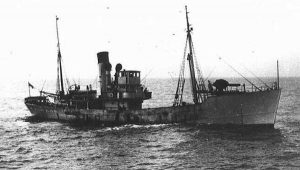Courage of HM Trawler lady Shirley
Tow hundred miles west-south-west of the Canary Islands the Atlantic rollers surge endlessly eastward towards the African shore. In October 1941, these were dangerous waters infested by German U-boats ever watching and waiting for the helpless merchantmen.
Among them was U111, a submarine of 750 tons, measuring 245 feet in length, and capable of exceeding 18 knots on the surface.
She was commanded by Kaptain-Leutnant Wilhelm Kleinschmidt, an experienced underwater sailor with a crew of fifty-one, which included 4 other officers and a ‘makee-learn’ prospective captain Korvetten-Kapitan Heinecke.
The morning of Saturday, October 4 1941, dawned bright and clear, with a little wind and a long low swell. U111 lay on the surface, her crew enjoying the early morning sun. The sea, as far as the eye could see, was empty, but unknown to Kleinschmidt, beyond his gaze as he scanned the horizon, lay the U-boats nemesis.
At 0820 on that October morning Lieutenant-Commander A H Callaway, Royal Australian naval Volunteer Reserve, commanding HM Trawler Lady Shirley, was scanning those same Atlantic wastes o f water when he sighted what he thought might be the funnel of a ship. Suspecting, however, that it could be the conning tower of a submarine, he turned his ship to investigate.
f water when he sighted what he thought might be the funnel of a ship. Suspecting, however, that it could be the conning tower of a submarine, he turned his ship to investigate.
Meanwhile Kleinschmidt had sighted smoke from Lady Shirley’s funnel and though not alarmed, decided to dive.
More than one hour and a half passed until at 1004 Commander Callaway’s patience was suddenly rewarded by an unmistakable contact. A pattern of depth charges was dropped, none of which damaged U111, but they certainly disturbed her crew. Kleinschmidt decided to surface, and barely had the rumble of the exploding canisters died away before the crew of the lady Shirley sighted the periscope rising from the depths.
Callaway swung his ship hard apart to bring his single 4inch gun to bear, and as the Conning tower slowly emerged, his gun crew opened fire at 500 yards range. The Germans running along the submarine’s deck to man the forward 4.1inch gun were sprayed with machine gun fire and either killed or driven back. The survivors, however opened fire with a machine gun and killed the gun-layer in lady Shirley, whose place was taken by Sub-Lieutenant F F French, RNR, who scored three hits in rapid succession.
The action lasted for another twenty minutes during which several of Lady Shirley‘s crew were severely injured and eight Germans, including the submarine captain, died. The 4-inch fire eventually proved effective and the U-boat crew abandoned their sinking vessel.
The U-boat was badly d amaged and already sinking by the stern when a few minutes later the surviving senior officer ordered abandon ship. Forty five Germans were taken from the water, one of whom was moved to comment “we were bigger than you, we could see you, but you couldn’t see us yet you beat us.” The trawler’s crew of thirty then had then had the problem of containing forty-four surviving German POWs for the return trip to Gibraltar.
amaged and already sinking by the stern when a few minutes later the surviving senior officer ordered abandon ship. Forty five Germans were taken from the water, one of whom was moved to comment “we were bigger than you, we could see you, but you couldn’t see us yet you beat us.” The trawler’s crew of thirty then had then had the problem of containing forty-four surviving German POWs for the return trip to Gibraltar.
The action had taken place in position 27.15N, 20.27W south west of Tenerife
On October 14 1941 Lieutenant-Commander Henry Callaway RANVR was awarded the DSO -” For great daring and skill in a brilliant action against a U-boat”. His First Lieutenant, another Australian, Lieutenant I P Boucaut RANVR, was awarded the DSC. In all another DSC, six Distinguished Service Medals, a Conspicuous Gallantry Medal and five Mentioned in Despatches were awarded to the members of the crew.
Unfortunately none of them lived to receive their decorations as these brave men and the gallant Lady Shirley disappeared without trace while patrolling the western approaches to the Straits of Gibraltar on 11 December 1941. She was sunk by a torpedo fired from U-374.
Based on an article in the Australia Navy Newspaper Jan 9 1959.




